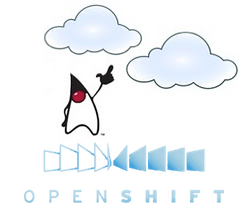Red Hat: Allow the OpenShift cloud to compile your Java applications.
 I decided to translate the news that OpenShift now combines Jenkins, JBoss Tools and Maven, allowing Java developers to program, build, deploy and scale the application in the cloud.
I decided to translate the news that OpenShift now combines Jenkins, JBoss Tools and Maven, allowing Java developers to program, build, deploy and scale the application in the cloud.Red Hat invites you to use OpenShift not only for hosting applications, but also for the entire software development cycle. You can program, compile and improve your software right in the "cloud" without using a desktop or a powerful laptop.
OpenShift - PaaS-cloud, the launch of which Red Hat announced in May. This cloud platform exists in three versions - Express, Flex and Power and is positioned as an alternative to Microsoft Azure or Google App Engine. The main advantage of cloud computing is that they automatically scale resources, as much as is required for the current load.
')
Express, the basic version of the cloud platform, supports Ruby, PHP, and Python applications. Java has been added to OpenShift Flex - JBoss middleware and Tomcat , DBMS - MySQL and MongoDB, as well as Memcached for web caching and some other functionality. The OpenShift Power version includes an imaging system that can be deployed on Amazon EC2, and, soon, on the IBM SmartCloud cloud infrastructure.
Probably, after Flex and Power become ready for industrial use, technical support will be available for them (unlike Express). According to Isaac Roth (Isaac Roth) - the head of PaaS referral at Red Hat, the OpenShift platform will be ready by mid-2012.
The new features of OpenShift, which Red Hat announced today, are expanding the cloud platform to become a build-as-a-service, or BaaS cloud. (Another ugly abbreviation.) For this, Red Hat built Jenkins into the OpenShift cloud. ( Jenkins is a fork of the open source project “Hudson”, which appeared this year because of a conflict between Oracle and developers .) MaShen , a framework for automating the assembly of projects, also became part of OpenShift. Finally, OpenShift integrates with Red Hat's IDE and JBoss Tools .
After you add all this, Issac explains, everything you do locally when creating and compiling an application, namely loading libraries from the repository, resolving dependencies for these libraries, compiling code, building the application, and finally deploying WAR- files on production servers - OpenShift will automagically do all this for you.
“Programmers can now use a less powerful desktop or laptop and become more mobile,” says Isaac. In addition, the compilation is likely to become faster. Instead of reloading all the code to the cloud each time, you can use JBoss Tools to transfer only the modified part to OpenShift. “Now you can program on the beach or in the bar,” Isaac jokes. “This is not just an opportunity to quickly make significant changes in the code, it is an opportunity to change lifestyle”
The OpenShift build service requires JBoss Application Server 7 in the “cloud” and JBoss Tools 3.3 M4 on the developer’s machine.
Source: https://habr.com/ru/post/132890/
All Articles